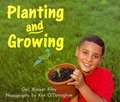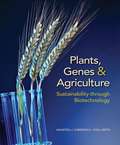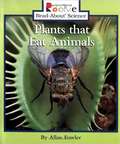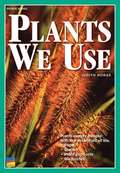- Table View
- List View
Planting and Growing (Into Reading, Level E #26)
by Ken O'Donoghue Gail RileyNIMAC-sourced textbook
Plants and Animals
by Lawrence Hall of Science University of California at BerkeleyNIMAC-sourced textbook
Plants and Animals (Delta Science Modules)
by Lawrence Hall of Science University of California at Berkeley Delta EducationNIMAC-sourced textbook
Plants And Animals: Biology and Production
by Jasper S. LeePlants and Animals: Biology and Production has been prepared to serve as an introductory textbook in plant, soil, and animal science. It is about far more than production of crops and livestock.
Plants and Animals in Different Seasons
by Kira Freed Tara FunkLearn how plants and animals change in different seasons.
Plants Everywhere (Fountas & Pinnell Classroom, Guided Reading Kindergarten)
by Madeline HydeNIMAC-sourced textbook
Plants, Genes, and Agriculture: Plants, Genes, and Agriculture
by Maarten Chrispeels Paul Gepts<p>What needs to happen if we are going to feed almost 10 billion people by the year 2050 in a sustainable way? Written for first- and second-year university students, this interdisciplinary textbook addresses this challenging question, presenting biological, economic, and sociocultural issues at an introductory level. <p>Presenting and integrating information from many disciplines, this book invites readers to consider the complexity of feeding humanity and increasing food production sustainably. <p>Topics covered include: <p> <li>the development, physiology, and nutrition of plants <li>human nutrition and food safety <li>photosynthesis and energy transformations <li>genetics, molecular biology, and genomics, including the techniques of genetic transformation (gene silencing, gene editing with CRISPR) used in modern crop breeding <li>crop domestication and plant breeding <li>soil ecosystems <li>the biotic (animal pests, diseases, and weeds) and abiotic (drought, flooding, temperature extremes, and soil degradation) stresses that limit crop production <li>technological advances and how new innovations (equipment, chemical products, and improved plant varieties) reach farmers and eventually affect what we eat; also discusses legal aspects (e.g., patents) relevant to agricultural innovations <li>plants as sources of pharmaceuticals and specialty chemicals</li> <p> <p>Although publicized in the controversies surrounding "genetically modified organisms" (GMOs), the applications of modern biotechnology to agriculture extend far beyond GMOs, and include crop improvements that rely on knowledge of the plant's genomes and its analysis by bioinformatics. This unifying theme of the text is stressed in coverage of a number of issues that appear throughout the chapters, including: <p> <li>how crop plant breeders look for specific traits to solve practical problems <li>genetic engineering of crops as a useful way to supplement conventional plant breeding <li>the nature of agribusiness in industrialized countries <li>the vital contributions of developing countries and their smallhold farmers, and the unique challenges facing them </li> <p> <p>Challenging and controversial topics such as the safety of pesticides and GMOs, the increasing demand for animal products and the stresses this puts on agricultural output, organic farming and foods, and patenting new crop varieties are dealt with in a balanced way, inviting teachers and students to consider all the implications of these serious questions.</p>
Plants That Eat Animals (Rookie Read-about Science: Plants And Fungi)
by Allan FowlerNIMAC-sourced textbook <P><P>Discover a variety of carnivorous plants, including the Venus fly trap, sundew, pitcher plant, and bladderwort.<P><P> The natural world comes alive for young readers (Ages 6-7) with Rookie Read-About "RM" Science! With striking, full-color photos and just the right amount of text, this series immediately involves young readers as they discover intriguing facts about the fascinating world around them.
Plants That Move, Spin, and Snap (Fountas & Pinnell Classroom, Guided Reading)
by Zeke ShepherdNIMAC-sourced textbook. Plants in Action. Plants can't get up and walk away. But that doesn't stop them from moving to get what they need.
Plants We Use
by Judith Hodge Pam HirschfeldFind out about how people around the world use plants for nutrition, shelter, medicine, and household items. (Set of 6 with Teacher's Guide and Comprehension Question Card)
Plants We Use (Into Reading, Level K #89)
by Lisa ShulmanWe use plants to make books, clothing, and other things. Find out how we use different parts of plants to make the things we need.
Plastic Eaters: Wax Worms on the Job (Fountas & Pinnell Classroom, Guided Reading Grade 6)
by Catherine JohnWorms Hold the Key Plastic is piling up everywhere, clogging landfills and oceans. Even as people around the globe recycle and reuse plastic, the problem persists. But scientists may have discovered a solution: WORMS! Yes, wax worms may hold the key to solving our plastic problem. Read on to discover why scientists are so excited about these white wiggly worms. NIMAC-sourced textbook
Plásticos: ¿Son buenos o malos? (¡Arriba la Lectura!, Level S #16)
by Phillip SimpsonNIMAC-sourced textbook
Plate Motion: Mystery of the Mesosaurus Fossils (Investigation Notebook)
by The Lawrence Hall of ScienceNIMAC-sourced textbook
Plate Motion: Mystery of the Mesosaurus Fossils (Article Compilation)
by The Lawrence Hall of ScienceNIMAC-sourced textbook




